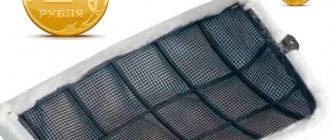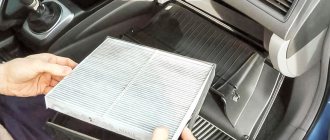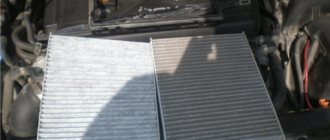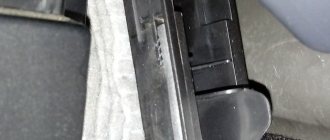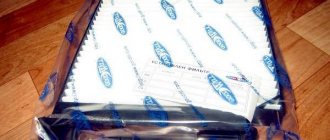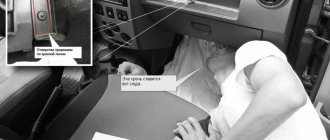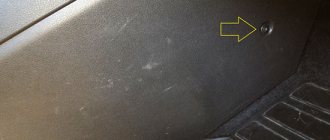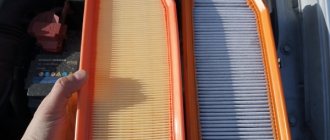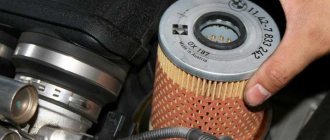The vehicle's cabin filter must be replaced twice a year or after fifteen thousand kilometers. The product is designed to clean the air entering the car interior from particles of dust, debris, exhaust gases and soot. The filter cannot be called a luxury product; rather, it protects the health of passengers and the driver; however, the price for good quality products is high. Not everyone can afford to buy new filters twice a year.
That’s why many car owners are interested in how to clean their car’s cabin filter. Let's try to figure out which elements can be mechanically cleaned and how to do this so that the product can be used after the end of its service life.
How long does it take to change the cabin filter?
Your car's owner's manual will tell you how often to change the cabin air filter. However, these figures are very general - 25 thousand km. With frequent trips around the city, during the time spent in traffic jams, the old cleaner quickly becomes clogged and requires replacement every 10 thousand km. If you rarely travel, then the cabin filter does not need to be changed so often. In summer, replacements are made more often, as there are more large particles in the air, such as lint and insects. In the autumn, if possible, it is worth looking into the filter cassette, as it may be clogged with dry leaves. Once water gets in there, the rotting process will begin, which will cause unpleasant odors. There are no further specific recommendations regarding the replacement period or frequency of replacing the cabin filter.
By following these simple recommendations, you can significantly extend the life of your car. Since the filter replacement procedure is not complicated, you can try to do it yourself. In this case, you may need to carefully remove the body and dashboard. If you are not sure that you will be able to do this yourself, it is better to turn to specialists. Replacing the cabin filter is not expensive, but you will be confident that everything is done correctly and will function normally.
What is an air filter?
Many car enthusiasts may not know what an air filter is, because it appeared not so long ago. But in most modern cars it is installed, since they are all equipped with advanced ventilation systems. What is this filter and why does it need to be changed? This filter allows you to clean the air that enters the cabin from all kinds of microparticles, such as dust, pollen, exhaust and much more. This way, you will breathe clean air inside the cabin as the air filter filters out all those particles that could contaminate your air. That is why it needs to be changed - after all, all this dust and dirt does not disappear, but settles on the filter. But there is another question: how often should the filter be changed?
Doctors reported: a drug for gout has been found effective for the treatment of COVID-19
Testing has been completed, the results are known: children will be vaccinated against COVID in 2021
We buy beans, prepare them in the correct proportion: the secrets of the most delicious coffee
How often is it recommended to change this element?
Different car manufacturers give their recommendations on when to replace the cabin filter, and these values differ markedly from each other. Some people prescribe changing it every 10 thousand kilometers, others - every 25 thousand.
But there is one general rule: the frequency of replacing the cabin filter depends on the intensity and climatic conditions of the car’s operation. If a car “operates” in a southern region with a high content of sand and other similar substances in the street air, its cabin filter will become dirty much faster than in a car operated in latitudes with cleaner air.
Affects the frequency of unit changes and the ratio of driving time in the city and outside the city.
If a car is driven for a significant amount of time within the city, is in heavy traffic and sits for hours in miles-long traffic jams, its cabin filter will become dirty much faster than that of a vehicle that is driven more often on country roads.
But regardless of the service conditions of the car and the manufacturer’s recommendations, the filter must be replaced at least once a year, even if the car has low mileage.
However, you shouldn’t fall for the tricks of unscrupulous workshop or car wash workers. If, during maintenance or cleaning of the machine, you are inclined to believe that a component needs to be replaced, first examine its appearance. Perhaps there is no need to change it yet.
We recommend that you read
- Granta cabin filter - replacement, features of the procedure on cars with air conditioning
- Replacing the Hyundai Accent fuel filter - how to do it yourself?
- Replacing the cabin filter in a VAZ 2114 car
An element has become unusable if its plates are very dirty, there is debris between them - leaves, small branches, soot, soot, insects. In this case, a new filter is really needed.
Similarities and differences
Air and cabin filters are very similar elements in terms of operation and final result. Both clean the air from dust, dirt and other microelements. The air filter has a more complex design than the cabin filter - at the same time, the air filter is quite variable depending on the specific car, while the cabin filter is more universal in use. These elements are not directly connected to each other, but work separately from each other. But, if the air filter serves for the correct and safe operation of the engine, the cabin filter provides comfort and clean air for the driver and passengers.
Auto and motorcycleComment
Why do you need a cabin filter?
Roadside air contains a lot of substances harmful to health: dust, combustion products of gasoline and diesel fuel. The main task of filters is to clean the air entering through the air conditioning and heating system from dust, fine particles, allergens, and eliminate odors. Some models have a bactericidal effect. The cabin filter is especially useful for people with allergies or asthma.
A visual diagram of why a cabin filter is needed and how it cleans the air when it enters the car interior
We recommend: Automotive low beam lamps H7 - a ray of light in the dark kingdom of the road
Cabin filter
This air purification element is found in every modern car. The cabin filter is no longer a luxury that wealthy car enthusiasts can afford. The air quality in the cabin, the intensity of airflow, and the reduction or complete removal of the concentration of harmful substances (nitrogen oxide, carbon monoxide, dust) depend on this filter. Depending on the design of the filter element, cabin filters are divided into cartridge and housing filters.
Cartridge filters are the most popular among car enthusiasts because they allow you to change the used plate (cartridge), rather than the completely assembled filter (housing with fastening and cleaning element). The cabin filter is located behind the glove compartment, most often closer to the driver's seat. A little less often it is installed directly under the hood - this is typical for many European cars.
It is located in front of the “stove”, so the purified air through the damper system will flow directly into the car interior.
The cabin filter can be carbon or simple, depending on the materials located on the plate. A simple filter consists of ordinary polypropylene, which traps dust and cleans the air of odors. The carbon version will be more effective - activated carbon, placed between the layers, copes well with unpleasant odors and cleanses the air of chemicals. But the price of a carbon filter will be noticeably higher.
The frequency of replacing the cabin filter may vary, but at least once a year. A certain mileage (15, 20, 50 thousand km), in this case, is also a very arbitrary guideline. Poor operation of the heating system, an unpleasant odor, fogging of the glass from inside the cabin, a filter element plate clogged with dirt and dust - these are the main signs of a worn-out cabin filter.
Step-by-step replacement procedure
Replacing the cabin filter yourself will require a set of screwdrivers and instructions for your car. Next, your actions are as follows:
- Locate the cabin filter.
- Remove the plastic grille on the hood. Its fastening is carried out using several bolts. Get rid of the plastic plugs, unscrew the bolts and remove the right side of the cladding.
- To provide further access to the filter, remove the washer tubes and protective cover.
- At the next stage you will need to tinker a little with the mounting bolts; when they are loosened, pull the cover up and to the right.
- Two plastic latches will hold the dirty filter. Replace it with a new one, following the arrows. Please note that the arrow does not determine the upper part of the filter device, but the direction of air flow - it should be directed downwards.
- At the final stage, you will be assembled in reverse order.
Types of cabin filters
When they first started installing cabin filters in cars, they were almost the same in composition as engine air filters. But the effect was not very good. Therefore, we decided to improve these filters and began making them two-layer. After using the two-stage filter, they further improved it and began to make it with three degrees of purification, the third layer is carbon.
Today's cabin filters capture even the smallest dust particles. The synthetic fibers from which such filters are made do not get wet and are antibacterial substances. Therefore, even in a clogged filter, the growth of fungi is reduced to zero.
The most optimal and effective type of cabin filter is one with the addition of carbon. Before the air enters the car interior, it is filtered three times. First, the filter will stop solid particles (soot, dust, sand, etc.), then harmful particles of gases, vapors, etc. will be removed from the air, and then the air will undergo antibacterial cleaning.
Three layers of filter:
- Polyester-propylene material. This is the first layer. Captures coarse particles of air impurities.
- Microfiber made of polypropylene. Delays various evaporations.
- Carbon layer. Cleans the air from harmful chemical impurities by 90%.
Types of cabin filter devices
The cabin air filter is a rectangular block with certain dimensions. Each device is equipped with a special material that performs filtration and looks like a corrugated plate. The frame is made of plastic, and its main purpose is to protect the plate from jamming and to hold it in the socket.
Based on the type of filter material used, devices can be divided into several types.
Barrier filter
This copy is made from the finest paper or linen (natural or synthetic). Such filters are designed to retain the smallest mechanical suspensions in the air . They clean the air flow entering the cabin only from dust (sometimes from small insects).
Carbon filter device
A small layer of carbon is applied to the filter material of such a device. is this that helps absorb hazardous impurities contained in the air and neutralize unpleasant odors. This filter has improved filtration qualities when compared with its barrier analogue. But it is important to know that over time the filtering properties of the key element (coal) are lost, which leads to their transformation into a regular filter.
Cabin air filter
Carbon element with special coating
In this version, an ordinary carbon filter has an additional polyphenol antioxidant coating. Such devices neutralize allergens . In them, a layer of activated carbon is applied to one side of a porous material, and a layer of polyphenols, a natural antioxidant, is applied to the other side. This sample has a higher cost and is most in demand during periods of flowering plants and increased activity of allergens.
Electret filter element
In addition to the ordinary linen layer, such a device is equipped with an additional electrically charged layer of thin fiber. The first layer is assigned the function of mechanical filtration, while the second one is responsible for attracting microscopic particles of all kinds of air impurities. Manufacturers of such devices claim that this filter blocks:
- 99% of various particles ranging in size from 5 to 100 microns. Such impurities include pollen, fungal spores, dust of various origins;
- over 65% of particles having a diameter from 0.3 to 1 microns (smoke/soot/bacteria);
- up to 35% of microscopic particles having dimensions equal to a hundredth of a micron.
Combination filter
This device combined carbon elements and electret layers . The device has several degrees of cleaning. In addition, multilayer filter devices are commercially available. They have a mechanical cleaning layer combined with an electrostatic, antiseptic and carbon layer.
Barrier and carbon filter devices are most in demand among Russian motorists, since they have the lowest price. Filters with anti-allergenic characteristics are premium class devices.
Cabin filter function
When installing a cabin filter device, it is important to know that any filter, regardless of the type and cost of the device, is a disposable element that must be replaced after a certain period of time.
Where is the cabin filter located in a Chevrolet?
The cleaning device in the Niva Chevrolet is located in the engine compartment, under the windshield on the passenger side.
The procedure for replacing it in these machines is the simplest. Simply unscrew the screws and remove the cover.
Location of the cabin filter in Chevrolet NIVA
The SF is located approximately in the same place on the Chevrolet Camaro . It is closed with a plastic panel in a vertical position.
Location of SF in other Chevrolet models:
Lacetti - in the housing under the glove box, in a vertical compartment closed with a lid with 4 bolts.
Location of SF in Chevrolet Lacetti
Spark - behind the glove compartment, in the horizontal compartment.
Chevrolet Tahoe - under the glove box, above the level of the feet of the front passenger. The compartment is located with the lid down, the element is pulled out downwards.
We extend the life of the cabin filter with our own hands
Filter elements must be replaced at the end of their service life. Additionally, experts recommend conducting regular preventive inspections of purifiers to avoid serious contamination.
To carry out regular replacements and inspections of the product, you need to understand where the air purifier is located in the car. It can be located behind the glove compartment in the dashboard or under the glove box on the passenger side. And also in some car models, the product is located under the hood near the windshield on the passenger side. Its exact location can be found in the technical documentation for the machine or on the Internet.
You can replace the air filtration element yourself, without contacting a service center. To dismantle the product, it is necessary to unscrew the fastening elements, most often these are screws or special latches. Next you need to carefully examine the product. If it is not heavily contaminated, you can clean the cabin filter yourself, thus extending its life.
Methods for cleaning the cabin filter depending on its type
Whether a car's cabin filter can be washed or how to properly clean it depends on the type of part installed on the vehicle. There are three main types of filters - paper-based, synthetic and carbon.
Paper-based filters are distinguished by their low price and appropriate quality. It can only be cleaned with a strong air flow. The easiest way to do this is with a vacuum cleaner with a small brush. It is strictly forbidden to wash it, since after contact with water the element will completely lose its shape.
We recommend: Effective measures to eliminate problems of poor operation of the stove on a VAZ-2114
Synthetic parts are characterized by higher quality and service life compared to the previous type of product. To extend the life of the air purification element, it can be washed or cleaned with a vacuum cleaner. For the most effective cleaning, first remove heavy dirt with a vacuum cleaner. Then, carefully, so as not to damage the product, you can wash it in warm water with powder or laundry soap. Next, you need to thoroughly rinse the product under running water and dry it very well. A completely dry product will be able to serve the owner for a little longer.
Coal elements differ from their predecessors in higher quality. They protect the car interior not only from debris and dust, but also trap unpleasant odors and various gas mixtures harmful to human health. It is not recommended to wash them, since along with particles of debris and dust, carbon particles, which are responsible for the effective operation of the product, will also be washed out. To extend the service life of such parts, the maximum that can be done is to clean it with a compressed air stream.
The air filter in the cabin and what it is used with or what every car owner needs to know!
Already now, car owners are becoming more competent than they were before and in most cases even have a good understanding of the structure and operating principle of its main units, and also carefully approach the timely issue of maintenance of their car. However, there are a number of auxiliary parts and systems that are not paramount, as a result of which car owners do not pay due attention to them, believing that this cannot in any way affect the operation of the car.
Here I would like to give an example: there is no car owner who does not take care of replacing the oil filter, which is designed to remove contaminants from motor, transmission, and lubricating oils. However, it is often forgotten that it is necessary to timely replace the filter element responsible for cleaning the air entering the car interior. As you most likely guessed, the article will talk about the car cabin filter.
What is the purpose of the air filter?
The air filter in a car is designed to remove harmful substances that enter the car interior through the air ducts of the ventilation system. And now many will have a question: why attach great importance to this if harmful substances enter the cabin even when the car doors are opened. And here, of course, you can’t argue, but there is a big but!
The concentration of substances entering the car interior when the doors are opened is not dangerous to human health; exceeding the concentration of hazardous substances is typical only for heavy traffic areas, when the traffic flow is quite dense. It is in this case that the exhaust pipe of the vehicle in front is almost closely adjacent to the air intake of the vehicle moving behind. It is in the immediate vicinity of the exhaust gas system that the permissible concentration limits of harmful components can be exceeded by 10-15 times.
Filter location.
The location of the cabin filter primarily depends on the make of the car. It will be located either under the dashboard on the driver's side or on the inside of the glove compartment, under the hood. If you still couldn’t find the location of the cabin filter, the car’s operating instructions will greatly simplify your search.
Cabin filters used in cars are divided into two most common groups:
- Conventional dust filters;
- Carbon filters.
Simple dust filters clean the air of dust and soot, as well as pollen and other allergens. These filters use paper or synthetic fiber as a filter element. The disadvantages of dust cabin filters include their absolute helplessness in the fight against toxic gases and unpleasant odors.
Replacing the filter
As we already wrote above, many car owners do not consider replacing the cabin filter a mandatory procedure, and some do not even suspect that it needs to be changed. The car owner must always remember that traffic safety depends not only on the owner’s experience, but also on his well-being and health, which is influenced by clean air in the cabin. As a rule, the service life of the cabin filter is always indicated in the operating book, but it is worth noting that the service life of the cabin filter depends on the operating conditions of the car and dust on the roads.
We also note that it is not worth judging whether the cabin filter is suitable or not by its appearance. Having served its intended period, the filter is no longer able to fight poisonous gases, and may even cause harm.
Some of the common signs that the cabin filter needs to be replaced.
You can determine when it is necessary to change this element in a car by the following signs:
- a persistent unpleasant odor was noticed inside the car;
- the air conditioner in the summer and the stove in the winter work at maximum, but the air flow is still not enough;
- The windows sweat, and there is an increased level of humidity in the cabin.
Consequences of using a used filter or its absence!
- In all cars, and especially with climate control, the filter must always be in good condition. If it is clogged or missing altogether, then after a short period of time you will need to clean the air system at a car service center, and this will cost much more.
- Another critical moment in the absence or malfunction of the filter is when the evaporator radiator freezes. Frozen dust will thaw over time and create an ideal habitat for bacteria and viruses.
- And if dust and dirt gets into the air conditioner or stove, you will need to completely dismantle the evaporator at a service station, which will again hit the car owner’s pocket, and after repair and cleaning, the air conditioner will need to be completely refilled.
- Do not forget about the malfunctions of the air system caused by the absence or contamination of the air filter, and this is damage to the electric motor of the cabin fan, failure of the additional resistance or the unit for adjusting the speed of the cabin fan, which entails serious financial and time losses. Also, often car owners or incompetent technicians incorrectly eliminate the consequences of such damage, which leads to more serious consequences, such as failure of the control system or fire...
A selection of photographs from the experience of the cabin air system:
Rice. 1 – the electric motor of the car interior fan burned out.
Rice. 2 – additional resistance for adjusting fan speed with a thermal fuse, which is often replaced with a jumper, which can lead to a fire.
Rice. 3 – Semiconductor interior fan speed controller.
Rice. 4 – Cabin filter, has not been changed for several years.
Rice. 5 — Repair of the car interior air system, usually due to improper operation.
In conclusion, I would like to say, be attentive to yourself and your car!
And that’s all for today, but don’t forget that there are not only cabin filters, but also many other equally important components of the car, but as they say, this is a completely different article...
What are the signs that it’s time to change the cabin filter?
Many people do not know when to change the cabin filter, but it is not difficult to understand. There are several signs that the cabin filter needs to be replaced:
1. The appearance of an unpleasant odor in the car interior. 2. Increased humidity in the cabin and fogging of the windows also makes it clear that it is time to change the cabin filter. 3. Poorly functioning heater and air conditioning indicate a component failure.
These signs do not always mean that there is a cabin filter, especially with regard to the last point. If the heater is not working well and the car does not warm up in winter, then most likely the thermostat is not working.
Even if you do not observe these signs, but often drive around the city and get stuck in traffic jams, you should take care of replacing the filter every 10 thousand km - this way you will eliminate the possibility of its complete clogging and improve the operating conditions of the car’s air system.
Since the cabin filter affects the microclimate in the car, not only the health of the air system depends on it, but also the well-being of the people in it, its replacement should be taken responsibly. A clogged filter will not provide sufficient air flow and may cause more serious problems. When the filter does not clean the air, it is time to replace it. At the same time, you can change the type of filter used - an adsorption filter copes with its functions much better than a conventional mechanical one, but its price will be higher.
Signs that replacement is needed
There are several signs that can tell you that it's time to change your air filter. Firstly, if it is clogged, the ventilation system will work weaker than usual. Secondly, if you turn the fan on maximum, it may start making strange sounds that should alert you. Moreover, you don't have to wait for obvious signs of contamination - in most cases, air filters are placed in such a way that you can easily access them and safely check their condition yourself.
Found a violation? Report content
Types of cabin filters
When choosing a new element, the main criteria will be its size and compatibility with a specific brand of car. And the type of it based on the main working material is chosen by the car owner himself based on personal preferences. The following types are available to choose from:
- Ordinary paper, made of porous paper and providing filtration exclusively at the mechanical level.
- Carbon, made from paper material with a special coating that can eliminate unpleasant odors and absorb some toxic gases.
- Carbon-polyphenolic, ideal for people with allergies to various particles floating in the air. This is also paper on which activated carbon and a polyphenolic composition are applied.
- Electret, very expensive, but most effective, containing in its design a special layer of thin fibers with an electrical charge.
Any type of cabin air filter element is a disposable consumable that must be replaced when it becomes dirty. Attempts to clean them with a vacuum cleaner or other means will not only not remove microparticles already retained by the element, but will also make the unit even more dangerous for the driver and his passengers.
Where is the cabin filter located?
The location depends on the imagination of the manufacturer, but there are several typical places:
- behind the glove box, better known as the glove compartment;
- under the dashboard;
- under the hood of the car.
One of the typical locations for the cabin filter is the space behind the glove compartment.
You can find out more precisely the location of the filter in the operating instructions for a specific model.
Features of replacing the filter on different cars
If you already know how to replace the cabin filter, all that remains is to understand the nuances of replacing different brands of cars:
- LADA Kalina The filter in this case is located under the hood. It is necessary to remove the glass lining by removing the plugs with a slotted screwdriver. Next, a standard screwdriver is used to remove the screws that secure the cover. Press down on the edges of the filter element and remove it, replacing it with a new one.
- Ford Focus II . The recommended replacement frequency is 25 thousand km. The location of the filter is under the steering wheel in a niche. Use a size 7 wrench to remove the 3 nuts from the gas pedal, unscrew the screws that hold the filter cover also using a size 7 wrench. The next procedure is similar.
- Nissan Qashqai . In this case, you will find the filter in the niche under the driver’s feet. Remove the plastic panel under the driver's feet using a socket wrench by sliding it to the side. To remove the flap, turn on the air conditioner at full power, https://www.youtube.com/watch?v=5c-IsWUIQ24 and it will fall out without your intervention. In this case, you won’t even need tools. At the next stage, it is necessary to get rid of the fastenings of the control unit of the air system of the machine. The filter is located immediately behind it. To get it out, bend the fasteners and pull. To install a clean filter element, bend it like an accordion.
- Chevrolet Lacetti . You will find the filter behind the glove compartment lid, which must be removed using a simple screwdriver. After unscrewing 5 screws, pull the structure towards you. To remove the filter from the niche behind the metal plate, just pull it.
- LADA Priora The replacement frequency in this case is 15 thousand km. Open the hood and find the sound insulation. Unscrew the two bolts that secure it and you will find the filter.
- VAZ-2112 . Since the filter here is protected by the windshield, the replacement procedure will be more labor-intensive than in previous cases. First, remove the bolts from the outside of the hood using a socket wrench or socket. Next, proceed to unscrew the screws under the hood using a classic screwdriver. Bend back a small part of the insulation and you will see the cover under which the filter is hidden. To speed up the procedure, first remove the washer reservoir and unscrew the 4 screws on which the lid is attached. When reassembling, remember that the corner of the filter element should be located behind the protrusion used to fix the sound insulation.
- Hyundai Solaris . The replacement frequency is also 15 thousand km, and you can get to the element being replaced through the interior and without additional tools, as in most Korean cars. The glove compartment valves must be unscrewed by hand and squeezed on the sides to remove them from the grooves. After dismantling the glove compartment, you will immediately see a niche for the filter.
How often should you change the cabin filter?
Car manufacturers often indicate completely different numbers in their operating manuals, but Bosch recommends changing the cabin filter every 15 thousand km or at least once a year - in the spring, before the start of the flowering season. Check the cabin filter periodically. If it becomes severely clogged, dirt and dust particles that penetrate further into the ventilation and air conditioning system can damage it. The result may also be the appearance of bacteria and mold, and subsequently a strong unpleasant odor in the car.
Your location can also greatly affect how often you change your filter. People who drive a car in a metropolis or any other city with poor air quality should change the cabin air filter more often. If you live in a desert area, your car's filter will also clog much faster.
Types of cabin filters
The cabin filter is a filter element made of synthetic fibers that are impregnated with antibacterial agents. Serves for filtration, that is, air purification, trapping harmful impurities from passing air. It seems like a small thing, but no, it’s about preserving the health of drivers and passengers. In addition, if you drive behind a truck with black smoke coming out of the muffler, breathing it in can cause you to get sick.
We recommend: Caution: painted! Preparatory work and organization of make-up
60%! percent of harmful substances are located a few meters from the surface of the earth. Depending on the city in which you operate the car, the service life of the cabin filter depends. In very dirty cities with huge traffic jams, these filters become dirty quickly.
You can notice that it’s time to change the filter by the smell of exhaust gases in the cabin, as well as by fogging of the windows. Some claim that the windows sweat due to the unimportant operation of the heating furnace. Yes, this can have an effect, but visibility can also depend on how dirty the cabin filter is.
How to check the engine oil level? On some engines, it is not clear where the dipstick is located to check the oil or whether it exists at all.
Filter change frequency
There are no specific instructions on the issue of replacing air filters - everything can depend on many factors, including the manufacturer. But on average it is said that it is best not to start this matter and change the filter every 20-25 thousand kilometers. The manual for your specific vehicle should include a schedule for necessary repairs, including a schedule for changing the air filter. But note that a lot depends on the conditions in which you drive. If the air along your route is usually clean, then you will need to change the filter less often than if you drive through a dusty city.
Where is the cabin filter in Fiat?
Fiat Palio. The air cleaner is installed to the right of the driver, just above the gas pedal. To replace the element, it is necessary to remove the lower steering casing and disconnect the interfering chips. Then the cartridge is pulled out of the compartment, pulling it to the left, towards the gas pedal.
Fiat Ducato, body 250. SF is located under the glove compartment at the bottom.
In Fiat Ducato 2015 and later, the device is located in the cabin, to the right of the driver, in the lower center of the cabin. To see the SF, you need to remove the plastic panels.
Location of SF in Fiat Ducato
In Fiats Doblo and Albea the device is located under the glove compartment.
There is no need to disassemble anything, just stick your head under the glove compartment and unscrew the unit cover.
Cabin filter in Fiat Doblo
As you can see, cabin filters can occupy different locations not only in cars of different brands, but also in the line of one brand. We hope you found our article useful. We wish you success in operating your favorite iron horse.
